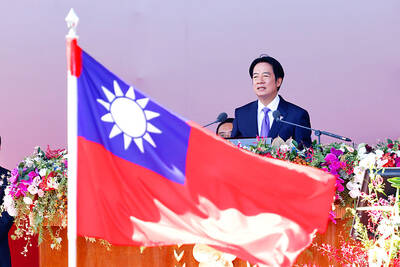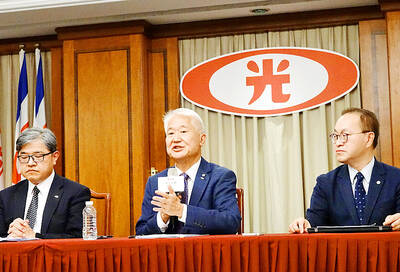Taiwan’s lack of response to the telephone call between US President Donald Trump and Chinese President Xi Jinping (習近平) on Friday last week was due to the US informing Taipei of the intended conversation prior to the call, Japan’s Sankei Shimbun reported yesterday.
During the call Trump agreed to “honor” the US’ “one China” policy.
According to the report, a “high-level” Taiwanese official said: “We are up to date on the issue; there is no need for unnecessary reaction,” seeming to imply that Taipei had prior knowledge of the call.
The “one China” policy is that Washington acknowledges Beijing’s position that Taiwan is part of China.
By contrast, Beijing’s “one China” principle states that both Taiwan and China are inalienable parts of a single “China” and that the People’s republic of China is China’s sole legitimate government, with peaceful resolution a possibility, but the use of force not excluded.
The report said that while Beijing praised Trump’s remarks about agreeing to honor the “one China” policy, the fact that Xinhua news agency made sure to use distinct terms indicated that “Xi is aware of the difference of attitude held by the US and China on the issue.”
The lack of response from Taiwan over the Trump-Xi call was seen as favorable, the Sankei Shimbun reported, adding that US Secretary of State Rex Tillerson had once again affirmed the US’ “six assurances” to Taipei.
The “six assurances” refer to the guidelines announced by then-US president Ronald Reagan in 1982 that the US would not set a date for ending arms sales to Taiwan; would not consult Beijing on arms sales to Taiwan; would not pressure Taiwan to negotiate with China; would not change its position on Taiwanese sovereignty; would not revise the Taiwan Relations Act; and would not mediate between Taipei and Beijing.
In Taipei, Presidential Office spokesman Alex Huang (黃重諺) said that “Taiwan has made its stance over the call very clear,” adding that the office does not comment on unsubstantiated media reports.
Asked whether Trump had informed Taipei before he made the call, an official familiar with the matter, who requested anonymity, did not deny it, adding that a White House statement had said that the agreement to honor the “one China” policy was at Xi’s request, meaning that Trump does not accept Beijing’s “one China” principle.
Additional reporting by Chung Li-hua

People can preregister to receive their NT$10,000 (US$325) cash distributed from the central government on Nov. 5 after President William Lai (賴清德) yesterday signed the Special Budget for Strengthening Economic, Social and National Security Resilience, the Executive Yuan told a news conference last night. The special budget, passed by the Legislative Yuan on Friday last week with a cash handout budget of NT$236 billion, was officially submitted to the Executive Yuan and the Presidential Office yesterday afternoon. People can register through the official Web site at https://10000.gov.tw to have the funds deposited into their bank accounts, withdraw the funds at automated teller

PEACE AND STABILITY: Maintaining the cross-strait ‘status quo’ has long been the government’s position, the Ministry of Foreign Affairs said Taiwan is committed to maintaining the cross-strait “status quo” and seeks no escalation of tensions, the Ministry of Foreign Affairs (MOFA) said yesterday, rebutting a Time magazine opinion piece that described President William Lai (賴清德) as a “reckless leader.” The article, titled “The US Must Beware of Taiwan’s Reckless Leader,” was written by Lyle Goldstein, director of the Asia Program at the Washington-based Defense Priorities think tank. Goldstein wrote that Taiwan is “the world’s most dangerous flashpoint” amid ongoing conflicts in the Middle East and Russia’s invasion of Ukraine. He said that the situation in the Taiwan Strait has become less stable

CONCESSION: A Shin Kong official said that the firm was ‘willing to contribute’ to the nation, as the move would enable Nvidia Crop to build its headquarters in Taiwan Shin Kong Life Insurance Co (新光人壽) yesterday said it would relinquish land-use rights, or known as surface rights, for two plots in Taipei’s Beitou District (北投), paving the way for Nvidia Corp to expand its office footprint in Taiwan. The insurer said it made the decision “in the interest of the nation’s greater good” and would not seek compensation from taxpayers for potential future losses, calling the move a gesture to resolve a months-long impasse among the insurer, the Taipei City Government and the US chip giant. “The decision was made on the condition that the Taipei City Government reimburses the related

FRESH LOOK: A committee would gather expert and public input on the themes and visual motifs that would appear on the notes, the central bank governor said The central bank has launched a comprehensive redesign of New Taiwan dollar banknotes to enhance anti-counterfeiting measures, improve accessibility and align the bills with global sustainability standards, Governor Yang Chin-long (楊金龍) told a meeting of the legislature’s Finance Committee yesterday. The overhaul would affect all five denominations — NT$100, NT$200, NT$500, NT$1,000 and NT$2,000 notes — but not coins, Yang said. It would be the first major update to the banknotes in 24 years, as the current series, introduced in 2001, has remained in circulation amid rapid advances in printing technology and security standards. “Updating the notes is essential to safeguard the integrity